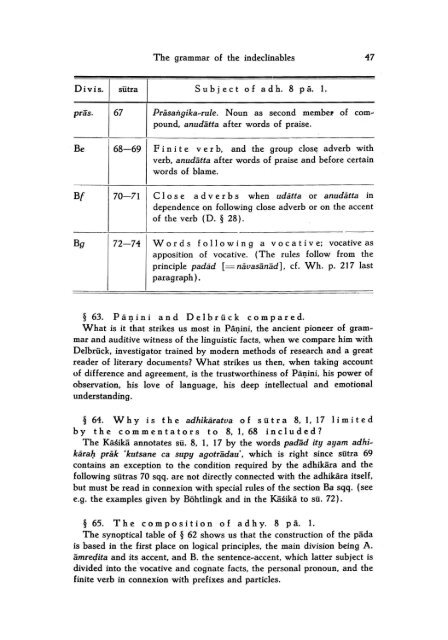Studies on Panini's grammar - DWC
Studies on Panini's grammar - DWC
Studies on Panini's grammar - DWC
Create successful ePaper yourself
Turn your PDF publications into a flip-book with our unique Google optimized e-Paper software.
The <strong>grammar</strong> of the indeclinables 47<br />
Divis. sütra Subject of ad h. 8 pä. 1.<br />
pras. 67 PräsaTigika-rule. Noun as sec<strong>on</strong>d membe! of compound,<br />
anudätta af ter words of praise.<br />
Be 68-69 Finite ver b, and the group cloSE; adverb with<br />
verb, anudätta af ter words of praise and before certain<br />
words of blame.<br />
Bf 70-71 Close adverbs when udátta or anudätta in<br />
dependence <strong>on</strong> following close adverb or <strong>on</strong> the accent<br />
of the verb (D. § 28) .<br />
-<br />
Bg 72-74 Words following a v 0 cat i v e; vocative as<br />
appositi<strong>on</strong> of vocative. (The rules follow from the<br />
principle padád [= nävasänäd]. cf. Wh. p. 217 last<br />
paragraph) .<br />
§ 63. P ä I). i n i a nd Del b r ü c k co m par e d.<br />
What is it that strikes us most in Päl).ini, the ancient pi<strong>on</strong>eer of <strong>grammar</strong><br />
and auditive witness of the linguistic facts, wh en we compare him with<br />
Delbrück, investigator trainoo by modern methods of research and a great<br />
reader of literary documents? What strikes us then, when taking account<br />
of difference and agreement, is the trustworthiness of Päl).ini, his power of<br />
observati<strong>on</strong>, his love of language, his deep intellectual and emoti<strong>on</strong>al<br />
understanding .<br />
§ 64. W by is t h e adhikäratva 0 f s ü tra 8, 1, 17 1 i m i t e d<br />
b y t h e c 0 mme n t a tor s t 0 8, 1, 68 i n c I u d e d ?<br />
The Käsikä annotates su. 8, 1, 17 by the words padäd ity ayam adhikáral}<br />
präk 'kutsane ca supy agoträdau', which is right since sütra 69<br />
c<strong>on</strong>tains an excepti<strong>on</strong> to the c<strong>on</strong>diti<strong>on</strong> required by the adhikära and the<br />
following sutras 70 sqq. are not directly c<strong>on</strong>nected with the adhikära itself.<br />
but must be read in c<strong>on</strong>nexi<strong>on</strong> with special rules of the secti<strong>on</strong> Ba sqq. (see<br />
e.g. the examples given by Böhtlingk and in the Käsikä to su. 72).<br />
§ 65. Th e co m pos i t i<strong>on</strong> 0 f a d h y. 8 p ä. 1.<br />
The synoptical table of § 62 shows us that the c<strong>on</strong>structi<strong>on</strong> of the päda<br />
is based in the first place <strong>on</strong> logical principles, the main divisi<strong>on</strong> being A.<br />
ämrec;lita and its accent, and B. the sentence-accent, which latter subject is<br />
divided into the vocative and cognate facts. the pers<strong>on</strong>al pr<strong>on</strong>oun. and the<br />
finite verb in c<strong>on</strong>nexi<strong>on</strong> with prefixes and particles.
















